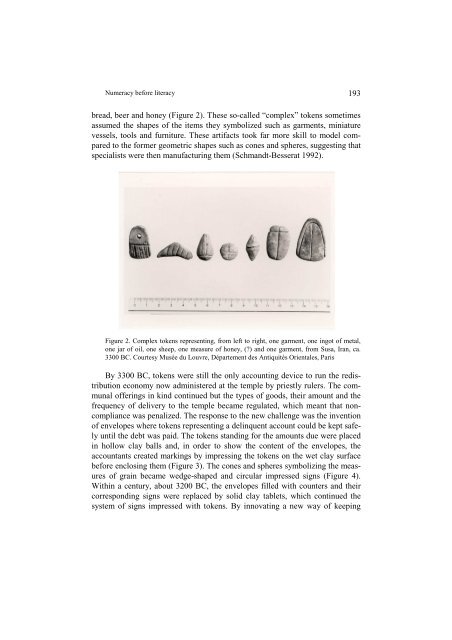s - Wyższa SzkoÅa Filologiczna we WrocÅawiu
s - Wyższa SzkoÅa Filologiczna we WrocÅawiu
s - Wyższa SzkoÅa Filologiczna we WrocÅawiu
Create successful ePaper yourself
Turn your PDF publications into a flip-book with our unique Google optimized e-Paper software.
Numeracy before literacy 193<br />
bread, beer and honey (Figure 2). These so-called “complex” tokens sometimes<br />
assumed the shapes of the items they symbolized such as garments, miniature<br />
vessels, tools and furniture. These artifacts took far more skill to model compared<br />
to the former geometric shapes such as cones and spheres, suggesting that<br />
specialists <strong>we</strong>re then manufacturing them (Schmandt-Besserat 1992).<br />
Figure 2. Complex tokens representing, from left to right, one garment, one ingot of metal,<br />
one jar of oil, one sheep, one measure of honey, (?) and one garment, from Susa, Iran, ca.<br />
3300 BC. Courtesy Musée du Louvre, Département des Antiquités Orientales, Paris<br />
By 3300 BC, tokens <strong>we</strong>re still the only accounting device to run the redistribution<br />
economy now administered at the temple by priestly rulers. The communal<br />
offerings in kind continued but the types of goods, their amount and the<br />
frequency of delivery to the temple became regulated, which meant that noncompliance<br />
was penalized. The response to the new challenge was the invention<br />
of envelopes where tokens representing a delinquent account could be kept safely<br />
until the debt was paid. The tokens standing for the amounts due <strong>we</strong>re placed<br />
in hollow clay balls and, in order to show the content of the envelopes, the<br />
accountants created markings by impressing the tokens on the <strong>we</strong>t clay surface<br />
before enclosing them (Figure 3). The cones and spheres symbolizing the measures<br />
of grain became <strong>we</strong>dge-shaped and circular impressed signs (Figure 4).<br />
Within a century, about 3200 BC, the envelopes filled with counters and their<br />
corresponding signs <strong>we</strong>re replaced by solid clay tablets, which continued the<br />
system of signs impressed with tokens. By innovating a new way of keeping
















